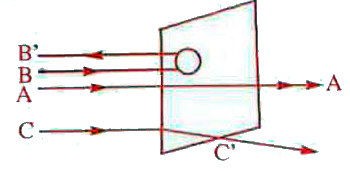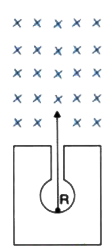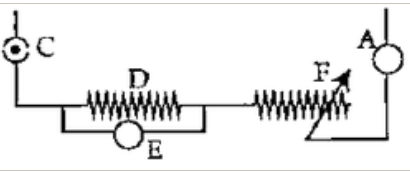A beam of fast moving alpha particles were directed towards a thin film pf gold. The parts A'B corresponding to the incident parts A, B and C of the beam, are shown in the adjoining diagram. The number of alpha particles. In-

B' will be minimum and in C' maximum
A' will be maximum and in B' minimum
A' will be minimum and in B' maximum
C' will be minimum and in B' maximum
The correct Answer is:B
Topper's Solved these Questions
- ATOMSBOOK - AAKASH SERIESCHAPTER - ATOMSEXERCISE - PROBLEM
24 Videos
- ATOMSBOOK - AAKASH SERIESCHAPTER - ATOMSEXERCISE - EXERCISE - I
21 Videos
- ATOMSBOOK - AAKASH SERIESCHAPTER - ATOMSEXERCISE - EXERCISE -II
35 Videos
- APPENDICES (REVISION EXERCISE)BOOK - AAKASH SERIESCHAPTER - APPENDICES (REVISION EXERCISE)EXERCISE - LAW OF MOTION
91 Videos
- CAPACITORS BOOK - AAKASH SERIESCHAPTER - CAPACITORS EXERCISE - PRACTICE SHEET (ADVANCED) (Integer Type Questions)
2 Videos
Similar Questions
A beam of fast moving alpha particles were directed towards a thin film of gold. The parts A',B' and C' of the transmitted and refected beams correcponding ro the incident parts A,B and C of the beam, are shown in the adjoining diagram. The number of alpha particles in

View SolutionA beam of α - particle is incident on a gold foil . Corresponding to the incident beams A , B and C , the emergent beams A' , B' and C' . The transmission and deflection of α - particles through the foil take place such that

View Solution
Knowledge Check
A beam of fast moving alpha particles were directed towards a thin film of gold. The parts A',B' and C' of the transmitted and refected beams correcponding ro the incident parts A,B and C of the beam, are shown in the adjoining diagram. The number of alpha particles in
 AB' will be minimum and in C' maximumBA' will be maximum and in B' minimumCA' will be minimum and in B' maximumDC' will be minimum and in B' maximum
AB' will be minimum and in C' maximumBA' will be maximum and in B' minimumCA' will be minimum and in B' maximumDC' will be minimum and in B' maximum
α- particles are incident on a thin gold foil. For what angle of deviation will the number of deflected α-particles be minimum ?
View SolutionIn Rutherford's α particle cexperiment with thin gold faill, 8100 scattered α-particles per unit ara per unit area per minute were observed at an anle of 60∘ . Find the number of scattered αparticles pr unit area per minut e at and angle of 120∘
View SolutionIn Rutherford's α particle cexperiment with thin gold faill, 8100 scattered α-particles per unit ara per unit area per minute were observed at an anle of 60∘ . Find the number of scattered αparticles pr unit area per minut e at and angle of 120∘
View SolutionFig. 12.8 shows a mixed source R of alpha and beta particles in a thick lead walled container. The particles pass through a magnetic field in a direction perpendicular to the plane of paper inwards as shown by x. (a) Show in the diagram how the particles get affected. (b) Name the law used in part (a).
[Hint : alpha particles will deflect to the left while beta particles to the right]

View SolutionA thin beam of charged particles in incident normally on the boundry of a region containing a uniform magnetic field as shown.The beam comprise of mono energetic α and β(−) particles, each possessing a kinetic energy T.Neglecting interaction between particles of the beam, find the separation between the points on line PQ where the α and β particles emerge out of the magnetic field.(express your answer in terms of T,B,α(2e,mα)&β−(−e,me),where all terms have their usual meanings.)

View SolutionA thin beam of charged particles in incident normally on the boundry of a region containing a uniform magnetic field as shown.The beam comprise of mono energetic α and β(−) particles, each possessing a kinetic energy T.Neglecting interaction between particles of the beam, find the separation between the points on line PQ where the α and β particles emerge out of the magnetic field.(express your answer in terms of T,B,α(2e,mα)&β−(−e,me),where all terms have their usual meanings.)

View SolutionIn the electric circuit shown in Fig., label the parts A, B, C, D, E, and E
State the function of each part. Show in the diagram the direction of flow of current.

View Solution
